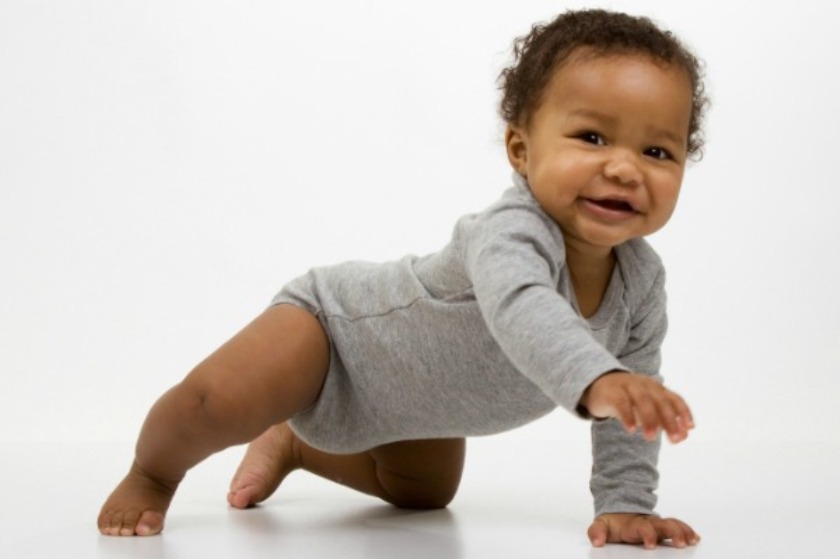Your Baby’s First Year Month By Month: Basic Milestones To Expect

Though babies develop at varying pace, here are a few typical ways your adorable newborn will develop in the first year of life, month by month…
Month 1
Baby’s neck muscles begin to develop to aid lifting his head. By the end of the first month, baby is able to lift up his head for a short period of time. He can also respond to loud voices and may turn towards familiar voices. You’ll also observe him turning his head to the opposite side of the position you place him.
He will also be able to maintain keen focus when caregivers talk to him, have stronger grasp reflex, follow objects moving in front of him with his eyes, make throaty sounds, see black and white patterns and keep quiet when he hears a voice or unusual sound.
Month 2
By the end of the second month, you will be enjoying lots of smiles from your baby. He should be smiling to himself, smiling in response to yours, and trying to get you and other caregivers to smile back at him.
He will also be able to track more moving objects with his eyes and eye crossing will gradually decrease, open and shut his hands, start mouthing, maintain eye contact, try to study faces, and make more interesting sounds.
In addition, his head bobs forward when he’s held in sitting position, his grasp reflex decreases, he is able to lift is head almost 45 degrees while lying on his stomach, makes noises apart from crying to communicate, his cries become more distinctive (you can tell when it means he’s sleepy, hungry or needs a diaper change) and he responds to familiar voices or stimuli.
Month 3
Your baby should be able to raise his head and chest all by himself when you lay him on his tummy at this stage. He’ll be kicking and straightening his legs if you lay him on his back too. He should also have good control head by now and be able to reach for dangling objects.
Babies this age are also able to hold their head up while in sitting position, though their head still bobs forward, hold objects, clutch their hands and pull at items. They can also bear weight on their forearms and start bearing partial weight on both legs when you hold them in standing position.
Your baby should also be able to locate sounds by turning his head and looking in the direction it came from, squeal, coo, babble and chuckle.
You’ll also notice your baby attempts to ‘talk’ when you engage him in conversations, recognizes faces, voices and objects, smiles at familiar people, shows interest in interacting with them, and expresses discomfort when in unfamiliar environment or meets strange people.
Month 4
Baby can now respond to his own name. Typically, most babies this age can roll from back to side, grasp objects with both hands, sit with support, and pull objects into their mouths. Some babies also begin drooling and teething at this stage.
Be mindful of the objects that your baby comes in contact with at this stage because of the crave to put everything they touche into their mouth.
In addition, most babies attain good head control by this age and eye-hand coordination begins.
Month 5
At this stage, baby should be able to sit for a short while with little or no support and use his hands to rake items at a distance from him, such as toys, towards him.
His visual capability is also extended as he can see across a room now. This stage is also one to expect the onset of teething.
Baby should also be able to hold head up while sitting, play with his toes, put feet in his mouth while lying down, roll from tummy to his back, smile at reflection in the mirror, and tell family and strangers apart.
Month 6
Baby starts copying some facial expressions at this point. He can also hold a bottle, keep head level when pulled to sitting position and make some vowel-consonant sounds.
Most babies can get into a crawling position by this point and become more attached to their parents. This age also marks the onset of solids for most babies, so, lots of chewing and biting occur.
Babies this age are also typically expected to be able to lift their chest and part of their tummy off the floor while on their tummy, bearing the weight on their hands. They are also able to bear more weight on their legs when held in standing position, turn head from side to side and subsequently look up or down.
They also begin saying a few one syllable words.
READ ALSO: Speech & Language Milestones for Children Below 6 Years: What to Expect
Month 7
Your baby can now tell when you are angry or happy by the tone of your voice as they are now able to distinguish emotions through your voice. Baby should also be crawling by now.
Most babies this age have started eating solids, can open their mouth for spoon feeding and drink from a cup with support. Some babies can feed themselves with finger foods too.
Your baby should also be able to bear his full weight on his feet, bounce when held in standing position, retain focus on small objects, bang objects on surfaces and bear weight on one hand during tummy time.
Month 8
Now, baby can adjust his posture to reach an object, reach for items at a distance, hold onto a table or wall and stand on his two legs, cruising. He reaches for utensils when being fed and turns away when he is full.
He may sleep for between 11 to 13 hours per night, with at least 2 naps during the day. He doesn’t need support while sitting anymore and has different reactions for individual family members. You’ll be able to tell those he is very fond of.
Month 9
Typically, baby begins moving by holding onto objects for support. He also understands simple questions and attempts to reply through incoherent responses. He goes from tummy to sitting by himself, identifies self in mirror reflection and tries to play with his reflection.
Your baby will likely also be able to pull himself up from sitting position when on the floor, use his thumb and index finger to pick up objects and may develop preference for the use of his right or left hand.
Month 10
By the end of the 10th month, baby can typically stand without support. He gets more upset when toys are removed and can transfer objects from hand to hand. He displays basic understanding of the concept of object permanence.
He should also be able to transit from stomach to sitting position, communicate using gestures, repeat familiar words, imitate words said to him as well as non-verbal forms of communication, express fascination at happenings around him, and show keen interest in picture books and interactive games.
Month 11
Most babies begin to say ‘ma-ma’ and/or ‘da-da’ discriminately, understand ‘no’, can nod and shake their head, as well as clap hands and wave bye-bye.
Baby also shows more curiosity and explores their environment more keenly, can place an object or more into a bigger one, can express frustration at failed attempts or restrictions, and excitement at successful attempts.
Baby can also drink and eat unsupported.
Month 12
Baby shows ability to be patient, ‘dances’ to music, shows interest in books, enjoys being read to, turns book pages, recognizes objects by their names, identifies and points at familiar objects, and can track rapidly moving objects with their eyes.
Their vocabulary is also expanding, and they can understand several words and sentences said to them.
Baby also shows affection, tests parental reactions to behaviour, extends arms and legs when getting dressed and shares toys but wants them back.
Some babies take their first steps by this age while others are already walking with little or no support.
Photo Credit: Google Images



Thanks…this is good
Oh cool. Thanks MIM.
A very good guide especially to mums who compare or can’t wait for baby to start the next milestone
Thank you MIM
Detailed…
thanx mim